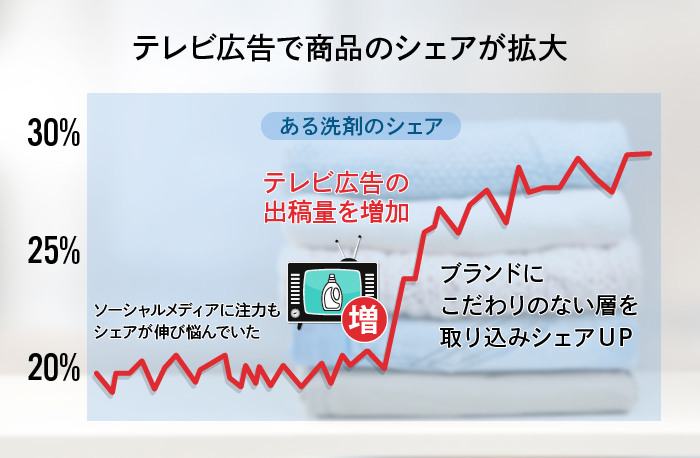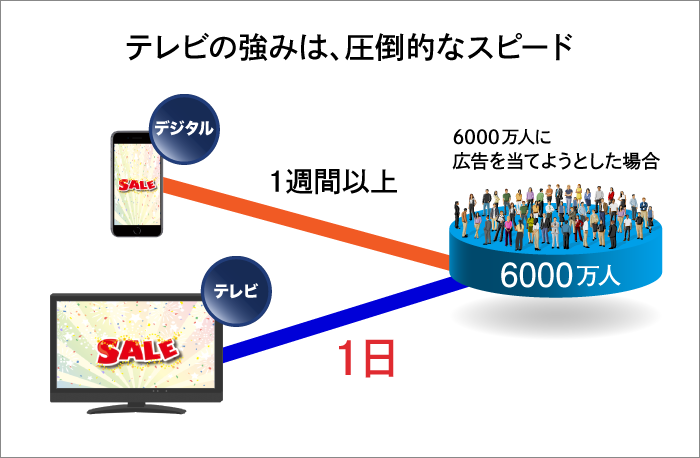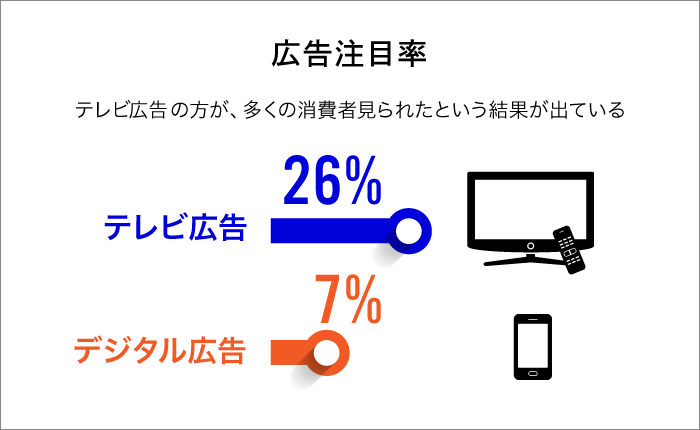What is required in the Reiwa era is marketing that leverages the unique characteristics of each medium. Among the many media available, where does television's strength lie?
Last year, I created a video titled "The 3UP Effect of Television." In preparing it, I revisited the effectiveness and value of television and contemplated its future direction.
The Power to Engage Mass Audiences: "Scale-Up"
The first of the "3UP Effects of Television" is "Scale-Up." Television has the power to engage and spark interest in large numbers of people, depending on the content.
While digital ads penetrate precisely at the "individual" level, TV ads can reach and appeal not only to the main target audience but also to the surrounding layers. Many clients who recognized this have shifted their previously digital-focused advertising strategies back to TV, resulting in increased sales.
For example, detergent brand X had been focusing heavily on digital ads and social media communication, but its market share was struggling to grow. The reasons likely included ads being ignored by non-brand-loyal consumers and insufficient reach to actual purchasing audiences. Increasing TV advertising then expanded the ads' ripple effect beyond the target audience, boosting product interest and leading to market share growth.

Created by the author based on data from Video Research Ltd. and INTAGE.
The Power of Quick Delivery: "Speed-UP"
The second is "Speed-UP." The speed of information delivery is another notable strength of television.
A typical TV ad campaign runs at 100 GRPs* per day. This translates to reaching a cumulative audience of 60 million people. Reaching the same cumulative audience of 60 million with digital video ads is said to take about a week. Television's overwhelming speed makes it ideal for capturing market share quickly.
※1 GRP: Gross Rating Point. The total rating achieved by airing a TV commercial over a set period. For example, airing a TV commercial once during a program with a 1% rating equals 1 GRP.

In one case study for a mobile app, it took "4.5 months" to reach 100,000 downloads using only digital advertising. In contrast, when TV commercials were deployed, downloads increased by approximately 9 times, achieving 100,000 downloads in just "0.5 months." Television's overwhelming speed makes it ideal for capturing market share in a short timeframe.
Interest-UP: The Power to Spark Interest
Finally, there's "Interest-UP," which sparks consumers' interest and attention.
Today's consumers spend a significant amount of time on their smartphones, meaning they are exposed to digital ads frequently. However, smartphone users tend to focus on ads that interest them but quickly dismiss those that don't. In other words, they rarely retain these uninteresting ads in their memory. Research shows that the ad attention rate (※2) among "low-interest" consumers for a product was only 7%.
※2 Ad Attention Rate: A score indicating ad recall. It measures whether an ad was seen by using the criteria: "Definitely saw it," "Think I saw it," or "Never saw it."
In contrast, for television, even among "low-interest" individuals, the ad attention rate was 26%. Since smartphones are a medium where users actively seek information, uninteresting content tends to be ignored. Television, however, being a passive medium, allows continuous advertising to capture the attention of even low-interest individuals.

Dentsu Inc. Original Ad Attention Rate Survey
Integrating TV and Digital Planning is Crucial
Of course, this does not mean digital advertising is ineffective. As mentioned earlier, digital ads are highly persuasive to interested viewers, and many cases show users transitioning to the official website of the advertised product or service after seeing the ad.
Furthermore, the purchase rate among those exposed to the ad can be equal to or even higher than that of TV. However, the very nature of pinpoint targeting makes it harder to scale up.
In media planning, there's a concept called "Reach Max." This approach assumes that while conversion numbers may be difficult to predict precisely, broad exposure will eventually convert a certain percentage of the audience into buyers.
Rather than prioritizing TV because of its large advertising budget or focusing solely on digital due to its strong conversion rates, it's crucial to plan mass media like TV by considering both sales and advertising budget.
Even in today's digital media-dominated landscape, television retains significant value due to its "3UP effect." It's vital to leverage the strengths of both digital and television in planning.





